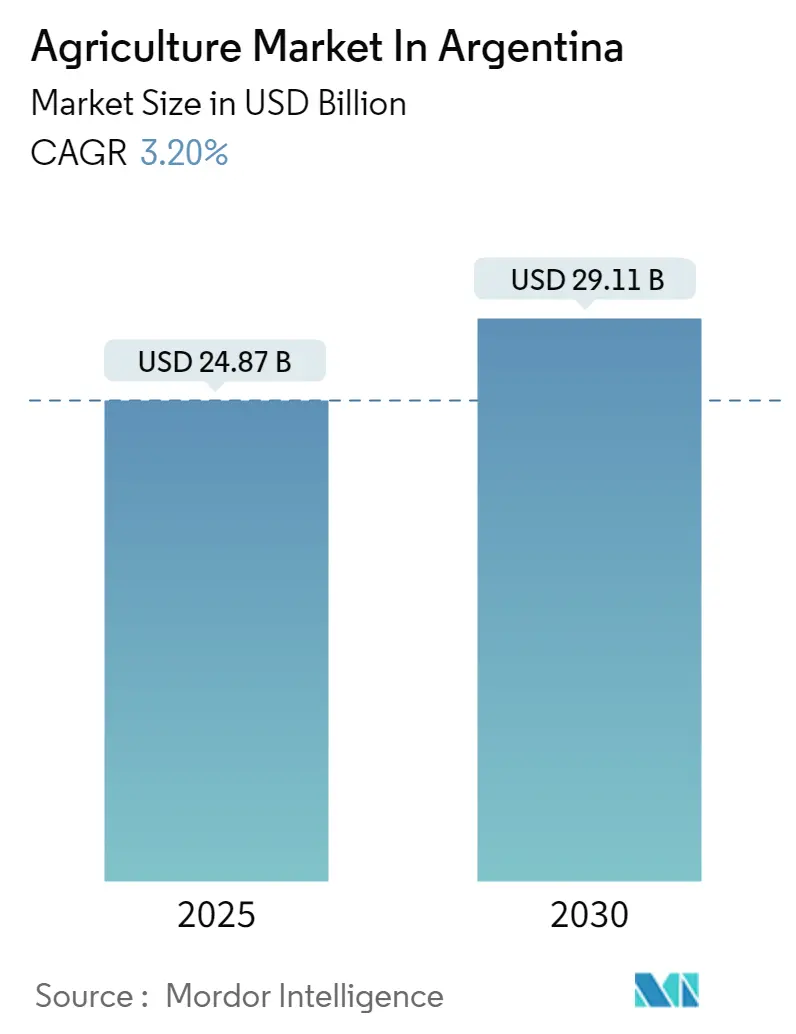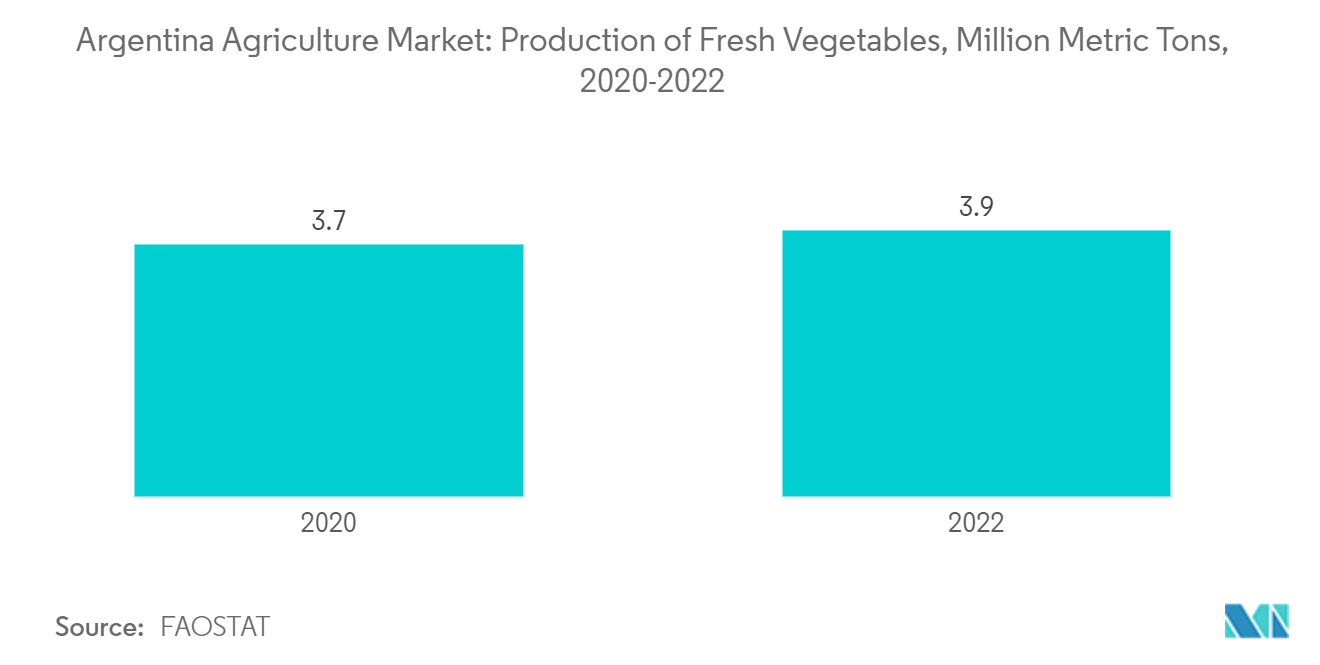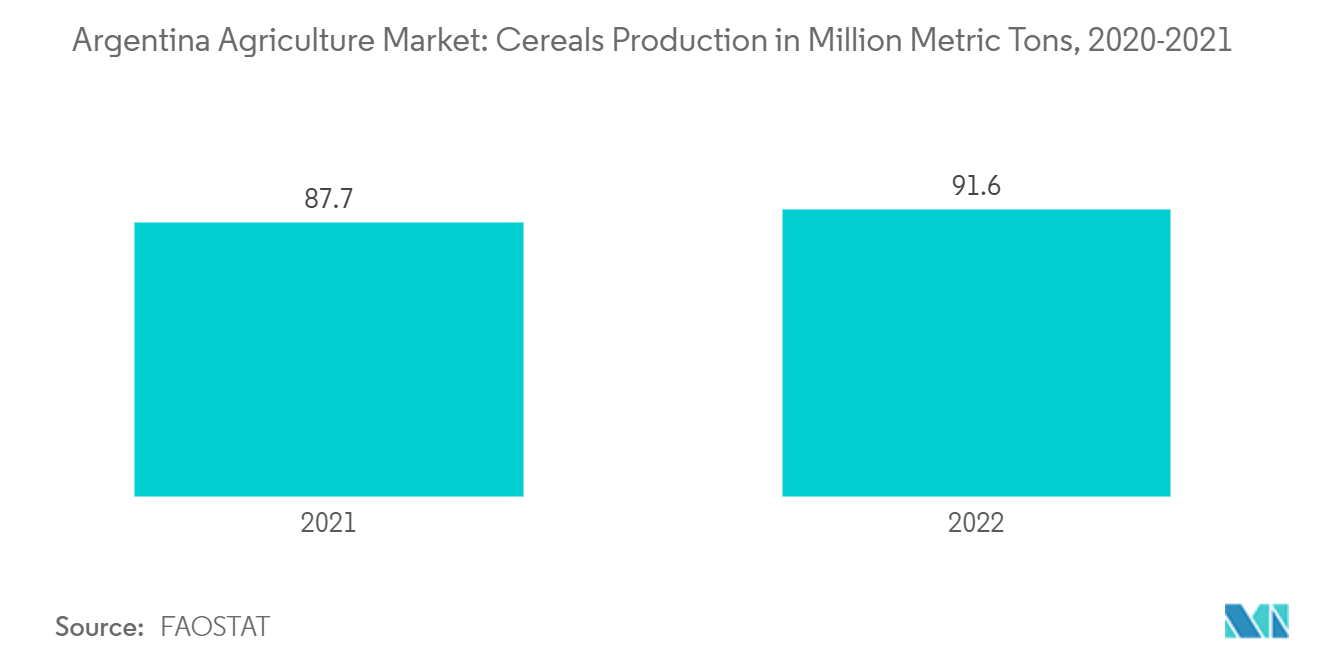
Argentina Agriculture Market Analysis
The Agriculture Market In Argentina Market size is estimated at USD 24.87 billion in 2025, and is expected to reach USD 29.11 billion by 2030, at a CAGR of 3.2% during the forecast period (2025-2030).
- Agricultural exports are crucial to Argentina's economy, constituting a quarter of the nation's total exports. Ranking as the world's 10th largest exporter of agri-food products, Argentina's agricultural sector stands as the country's primary income source. This sector employs over a third of the labor force (including indirect employment) and contributes around 8.3% to the GDP, which rises to 20% when considering the entire value chain. Argentina's agricultural landscape is dominated by soybeans, corn, and wheat, alongside significant production of fruits and vegetables.
- Cereals and grains are leaders in terms of agricultural production, followed by oilseeds, cash crops, fruits, and vegetables. Argentina's wheat crop production was 17.6 million metric tons in 2021, which increased to 22.2 million metric tons in 2022. Argentina is the foremost producer of fruits and vegetables, such as grapes, bananas, apples, limes and lemons, pears, onions, garlic, potatoes, and tomatoes. According to USDA, the domestic consumption of fresh oranges was 608,000 MT in 2023, up 64% from the previous year due to high supply availability.
- In 2021, the World Bank approved a USD 400 million loan to implement climate-smart, innovative practices to boost the productivity and competitiveness of agri-food systems and green development through investments in climate-resilient infrastructure in Argentina. The project will seek to support institutional strengthening processes in the National Agricultural Technology Institute (INTA) to promote its leadership in innovation and climate resilience in the agri-food sector. Furthermore, the increasing adoption of genetically modified seeds in Argentina's agriculture market is leading to high crop production, thereby boosting the adoption of loan facilities among small and marginal farmers and investments in export and import scenarios.
Argentina Agriculture Market Trends
Rising Health Awareness Has Boosted the Demand for Fruits and Vegetables
The increasing concern about health consciousness is leading to more consumption of fruits and vegetables, including the high import of off-season varieties into the market. There are some major fruits and vegetables, such as carrots, peppers, onions, chilies, beans, turnips, tomatoes, oranges, grapes, apples, peaches, avocados, and strawberries, that are expected to witness significant market growth potential in Argentina during the coming years. According to FAOSTAT, fresh vegetable production was 3.7 million metric tons in 2020, which increased to 3.9 million metric tons in 2022. Fresh fruit production was 6.7 million metric tons in 2021, which increased to 7.1 million metric tons in 2022.
Rising demand for organic food to minimize the chances of chronic diseases like cancer, hypertension, and diabetes among the population is anticipated to drive the Argentine agriculture market during the forecast period. Government agencies are implementing several agricultural policies and services to promote economic and infrastructural development in the country. For instance, the National Institute of Agricultural Technology (INTA) provides technical assistance for innovation in value chains, agricultural R&D, and extension services for small-scale producers.
The Argentine government adjusted export taxes on a variety of specialty crops, including apples, pears, citrus fruits, blueberries, tomatoes, broccoli, cauliflower, nuts, and alfalfa. The revisions set uniform export tax rates of 0%, 3%, 4.5%, and 9% across all the crops.
This initiative seeks to harmonize export tax rates among similar products, thereby fostering the export of value-added goods. The government is prioritizing products where a surge in production could boost employment, and increased exports would not drive up food prices. Furthermore, there is a strong emphasis on drawing investments to enhance domestic production and stimulate market growth during the forecast period.

Cereals and Grains is the Leading Segment in the Market
Producers' widespread adoption of crop diversification, particularly in cereals and grains, plays a pivotal role in risk management and soil sustainability. Cereals such as wheat, sorghum, corn, and barley enhance carbon fixation in the soil and promote denser vegetative coverage. This, in turn, mitigates soil and wind erosion and bolsters resistance to both biotic and abiotic stresses. According to FAOSTAT, cereal production rose from 87.7 million metric tons in 2021 to 91.6 million metric tons in 2022. In 2023, Argentina emerged as the leading producer and exporter of wheat in South America. Brazil stood out as a major importer, sourcing 94% of its wheat from Argentina, with Peru and Chile accounting for 4.5% and 1.3%, respectively.
Additionally, Argentina is researching genetically engineered new wheat known as HB4, which can use a gene taken from sunflowers. If successful, Argentina could keep its position as one of the world's top wheat exporters and might ease some agricultural concerns for the future, which would also drive the growth of the market. Currently, China and countries in North America and Europe are at lower than usual levels of wheat production because of drought. Also, the Russia-Ukraine War reduced the global wheat supply.
The rise in areas for silos for cereals and grains is also a key driver in enhancing the quality of logistics services and minimizing post-harvest losses. Additionally, silos minimize the risk of macroeconomic instability and shortage in credit among the farmers, thereby supporting the storage and transportation of the produce will boost the growth of the market in coming years.

Argentina Agriculture Market News
- August 2023: The Minister of Agriculture and Livestock unveiled the Crop Plan, channeling USD 66.4 billion to bolster domestic agricultural output. This Crop Plan emphasizes environmentally sustainable production systems. It also introduced reduced interest rates for pasture recovery and incentives for rural producers embracing sustainable agricultural practices.
- December 2022: Argentina harvested a record 21.8 million metric tons of wheat in 2022, which was a significant increase compared to the previous year. The country is a key wheat supplier to many countries, primarily Brazil. However, with the reduction in global supplies from Russia, the United States, and Canada, countries in the Middle East looked toward Argentina to meet their requirements.
- September 2022: The government of Argentina and IICA intensified their long-standing joint experience in South-South cooperation projects to support Central American and Caribbean countries facing food security problems and particularly vulnerable to natural disasters, which had increased in frequency and severity due to climate change.
Argentina Agriculture Industry Segmentation
Agriculture is the art and science of cultivating the soil, growing crops, and raising livestock. The scope does not include agricultural products processed in any form, such as frozen, freeze-dried, cooked, or canned food.
The Argentine agricultural market is segmented by type (cereals and grains, oilseeds, fruits, vegetables, cash crops, and turf and ornamentals). The report includes production analysis (volume), consumption analysis (value and volume), export analysis (value and volume), import analysis (value and volume), and price trend analysis. The market sizes and forecasts are provided in terms of both value (USD) and volume (metric tons) for all the above segments.
| Cereals & Grains | Production Analysis |
| Consumption Analysis | |
| Import Analysis by Volume and Value | |
| Export Analysis by Volume and Value | |
| Price Trend Analysis | |
| Oilseeds | Production Analysis |
| Consumption Analysis | |
| Import Analysis by Volume and Value | |
| Export Analysis by Volume and Value | |
| Price Trend Analysis | |
| Fruits | Production Analysis |
| Consumption Analysis | |
| Import Analysis by Volume and Value | |
| Export Analysis by Volume and Value | |
| Price Trend Analysis | |
| Vegetables | Production Analysis |
| Consumption Analysis | |
| Import Analysis by Volume and Value | |
| Export Analysis by Volume and Value | |
| Price Trend Analysis | |
| Cash crops | Production Analysis |
| Consumption Analysis | |
| Import Analysis by Volume and Value | |
| Export Analysis by Volume and Value | |
| Price Trend Analysis | |
| Turf and Ornamentals | Production Analysis |
| Consumption Analysis | |
| Import Analysis by Volume and Value | |
| Export Analysis by Volume and Value | |
| Price Trend Analysis |
Argentina Agricultural Market Research FAQs
How big is the Agriculture Market In Argentina Market?
The Agriculture Market In Argentina Market size is expected to reach USD 24.87 billion in 2025 and grow at a CAGR of 3.20% to reach USD 29.11 billion by 2030.
What is the current Agriculture Market In Argentina Market size?
In 2025, the Agriculture Market In Argentina Market size is expected to reach USD 24.87 billion.
What years does this Agriculture Market In Argentina Market cover, and what was the market size in 2024?
In 2024, the Agriculture Market In Argentina Market size was estimated at USD 24.07 billion. The report covers the Agriculture Market In Argentina Market historical market size for years: 2019, 2020, 2021, 2022, 2023 and 2024. The report also forecasts the Agriculture Market In Argentina Market size for years: 2025, 2026, 2027, 2028, 2029 and 2030.
Our Best Selling Reports
Agriculture in Argentina Industry Report
Statistics for the 2025 Agriculture In Argentina market share, size and revenue growth rate, created by Mordor Intelligence™ Industry Reports. Agriculture In Argentina analysis includes a market forecast outlook for 2025 to 2030 and historical overview. Get a sample of this industry analysis as a free report PDF download.


